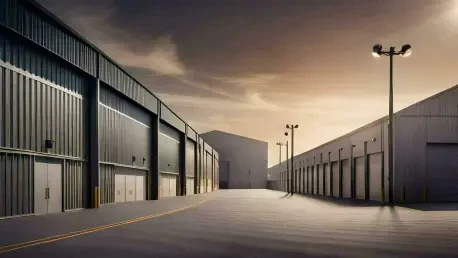Understanding the Logistics Real Estate Landscape
The logistics real estate sector stands as a cornerstone of global commerce, experiencing unprecedented growth amid the surge of e-commerce and evolving supply chain demands. This industry has become vital in ensuring goods move efficiently from manufacturers to consumers, with last-mile delivery emerging as a critical component in urban centers. The rapid expansion of online shopping has amplified the need for strategically located warehouses to facilitate quick turnarounds, positioning logistics real estate as a high-priority investment area for institutional players.
Key firms like Crossbay have capitalized on this momentum, focusing on premium assets in densely populated markets. The rise of e-commerce giants and consumer expectations for same-day or next-day delivery have fueled demand for facilities that can bridge the gap between regional distribution hubs and end customers. Urban logistics properties, often situated near major transportation nodes, have thus become hot commodities, drawing significant capital from investors seeking stable returns in a dynamic market.
Barcelona, with its proximity to a major port and status as a gateway to Southern Europe, exemplifies the importance of location in this sector. Strategic positioning near large metropolitan areas allows for optimized delivery routes, reducing costs and enhancing service levels. As supply chains continue to adapt to global trade patterns, cities like Barcelona remain pivotal in shaping the logistics real estate landscape, driving both competition and innovation among market participants.
Key Trends in Last-Mile Logistics Investments
Rising Demand for Urban Logistics Assets
Urban logistics assets, particularly those catering to last-mile delivery, are witnessing a dramatic surge in demand, especially in densely populated regions with limited available space. The push for faster delivery times, driven by consumer expectations and the dominance of e-commerce platforms, has made proximity to city centers a non-negotiable factor. This trend underscores the critical role of efficient distribution networks in meeting modern retail challenges.
Several factors contribute to this heightened interest, including the exponential growth of online sales and the necessity for warehouses that can handle high throughput. Investors are increasingly drawn to properties that offer scalability and adaptability to rapid market shifts. The focus on urban logistics also reflects a broader shift toward optimizing supply chains to minimize delays, a priority for retailers competing in a fast-paced digital economy.
Sustainability has emerged as a defining criterion for these investments, with certifications like BREEAM becoming a benchmark for quality. Assets designed with energy efficiency and eco-friendly features attract institutional capital, as tenants prioritize facilities that align with corporate environmental goals. This growing emphasis on green design is reshaping how logistics properties are developed and marketed in competitive urban markets.
Market Performance and Growth Outlook
Current data paints a robust picture of the logistics real estate market, particularly in prime locations like Barcelona, where vacancy rates for Grade A assets in the first logistics ring hover below 1%. Rental growth in such areas has been strong, averaging a 10% increase annually over recent years, reflecting tight supply and soaring demand. These metrics highlight the sector’s resilience and attractiveness to investors seeking long-term value.
Transactions such as the recent sale of a Barcelona asset by Crossbay to AB Sagax, a Stockholm-listed real estate investor, demonstrate the intense competition for high-quality logistics properties. The deal, characterized by a highly competitive bidding process, signals strong institutional appetite for assets in supply-constrained sub-markets. Such sales processes are becoming commonplace as capital continues to flow into logistics hubs across Europe.
Looking ahead, the outlook for logistics real estate remains positive, with prime urban locations expected to drive sustained growth through at least 2027. The ongoing expansion of e-commerce and the need for modern, efficient facilities are likely to keep investor interest elevated. As markets mature, the focus on strategic acquisitions and development in key cities will shape the sector’s trajectory, reinforcing its status as a cornerstone of real estate investment.
Challenges in the Logistics Real Estate Sector
Supply constraints pose a significant hurdle in key urban markets, where the availability of land for last-mile facilities is increasingly scarce. High demand for proximity to population centers has outpaced the ability to develop new properties, creating a bottleneck that frustrates both investors and operators. This imbalance often results in intensified competition for existing assets, driving up costs and complicating expansion plans.
Balancing sustainability objectives with the financial realities of development presents another layer of complexity. High construction costs and the pressure to deliver projects on tight timelines can strain budgets, especially when incorporating green technologies or meeting stringent environmental standards. Developers must navigate these challenges while ensuring that assets remain attractive to discerning tenants and investors.
Potential solutions to these issues include speculative development, as evidenced by initiatives under Crossbay II, which aim to preempt demand by building ahead of confirmed leases. Additionally, partnerships with local authorities can unlock new sites for logistics use, easing supply constraints through zoning adjustments or infrastructure support. These strategies, while risky, offer pathways to address the sector’s most pressing obstacles and sustain growth.
Regulatory and Sustainability Standards in Logistics Real Estate
The logistics real estate sector is increasingly shaped by stringent sustainability regulations, with certifications like BREEAM setting the standard for new developments. Compliance with these benchmarks is no longer optional but a critical factor in determining an asset’s marketability. Developers are compelled to integrate energy-efficient systems and sustainable materials to meet both regulatory mandates and tenant expectations.
This focus on environmental responsibility influences every aspect of logistics property design and operation, from construction methods to daily management practices. Features such as solar panels, advanced insulation, and optimized layouts are becoming commonplace in high-quality assets. These elements not only reduce operational costs but also enhance the long-term value of properties in a market that prioritizes green credentials.
Sustainable properties, as demonstrated by Crossbay’s portfolio, hold a distinct competitive edge in attracting both tenants and institutional investors. Assets with strong environmental ratings often command premium rents and lower vacancy periods, reflecting a growing preference for facilities that align with broader corporate sustainability goals. This trend is likely to intensify as regulatory frameworks evolve, further embedding sustainability into the sector’s core.
Future Directions for Logistics Real Estate Investments
Emerging opportunities in logistics real estate are centered on niche segments such as single-user warehouses, which offer tailored solutions for large tenants. Refurbishment projects also hold significant potential, allowing investors to modernize older assets and meet contemporary standards. These strategies enable firms to capitalize on existing infrastructure while addressing the specific needs of e-commerce and distribution companies.
Innovation plays a pivotal role in shaping the future of last-mile facilities, with automation and green technologies driving efficiency and reducing environmental impact. Robotics, data analytics, and renewable energy systems are being integrated into warehouse operations, enhancing productivity and sustainability. Such advancements position logistics properties at the forefront of technological progress in real estate.
Global economic factors, shifting consumer behaviors, and the strategic expansion of investment vehicles like Crossbay II will continue to influence market evolution. The focus on prime urban locations, coupled with a commitment to modernization, suggests that logistics real estate will remain a dynamic and lucrative field. As capital markets adapt to these trends, the sector is poised to attract diverse players seeking to leverage its growth potential.
Conclusion
Reflecting on the insights gathered, Crossbay’s strategic sale of a Barcelona logistics asset underscored the immense value placed on prime, sustainable properties in constrained urban markets. The transaction, alongside the transition from Crossbay I to Crossbay II, highlighted the firm’s adept navigation of market dynamics during a period of intense demand. This move mirrored broader industry shifts toward modernization and environmental responsibility.
Looking back, the competitive nature of the sale to AB Sagax revealed the depth of institutional interest that characterized the sector at that time. Moving forward, stakeholders should prioritize innovative development models, such as speculative builds and partnerships with local governments, to alleviate supply shortages. Embracing automation and green technologies will also be crucial in maintaining a competitive edge.
As the logistics real estate landscape continues to evolve, investors and developers must remain agile, focusing on strategic acquisitions in key urban hubs. Exploring untapped sub-markets and investing in scalable, future-proof assets can further solidify the sector’s resilience. These steps will ensure that the industry not only adapts to past challenges but also thrives in the face of emerging opportunities.









